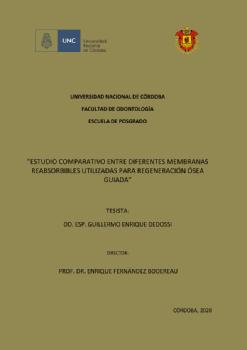| dc.contributor.advisor | Fernández Bodereau, Enrique | |
| dc.contributor.author | Dedossi, Guillermo Enrique | |
| dc.date.accessioned | 2021-05-05T14:16:39Z | |
| dc.date.issued | 2020 | |
| dc.identifier.uri | http://hdl.handle.net/11086/18132 | |
| dc.description.abstract | El propósito del presente estudio es analizar el comportamiento de diferentes membranas reabsorbibles para Regeneración Ósea Guiada de producción nacional y establecer cuales brindan los mejores resultados, en un modelo animal, Oryctolagus cuniculus, raza neozelandesa.
Materiales y Métodos: Se practicaron defectos óseos críticos en las calotas craneanas de los especímenes (n=80), la mitad de los defectos fueron rellenados con injerto óseo xerográfico y la otra mitad sin material agregado. Fueron cubiertos los defectos con cuatro diferentes membranas reabsorbibles y un grupo no llevo membrana (control). Se sacrificaron a las 4 y 8 semanas. Se realizaron estudios micro tomográficos de alta resolución a las muestras fijadas y luego estudios histomorfométricos.
Resultados: Se verificaron diferencias significativas entre las membranas utilizadas (p=0,005; p<0,05), con valores medios de densidad radiográfica significativamente menores en los grupos con membrana de pericardio y sin membrana respecto a los grupos con membranas amniocoriónica, de colágeno y fascia lata. Con respecto al factor tiempo, en términos globales no resultó significativo (p=0,614; p>0,05). Histológicamente, el factor material de relleno mostró un efecto muy significativo (el más significativo) sobre la densidad de tejido óseo neo formado y/o material de relleno residual (p=3,0x10-11; p<0,05), también el
efecto del factor membrana resultó muy significativo (p=4,5x10-9 ; p<0,05).
Conclusiones: Existen diferencias significativas de rendimiento en cuanto a calidad y cantidad de hueso debajo de las diferentes membranas estudiadas. Se observó pobre rendimiento en los grupos sin membrana y con membrana de pericardio porcino, y mejores rendimientos en los grupos de membranas amniocoriónicas humanas, fascia lata humana y de colágeno reconstituido.
Se destaca la validación de ambos métodos, micro-tomografía de alta resolución e Histomorfometría para este tipo de trabajo y la correlación de resultados entre ello. | es |
| dc.description.abstract | The purpose of the present study is to analyze the behavior of different reabsorbable membranes for Guided Bone Regeneration of national production and establish which provide the best results, in an animal model, Oryctolagus cuniculus, New Zealand rabbits.
Materials and Methods: Critical bone defects were performed in the cranial calves of the specimens (N=80), half of the defects were filled with xerographic bone graft and the other half without added material. Defects were covered with four different resorbable membranes
and one group had no membrane (control). They were sacrificed at 4 and 8 weeks. High resolution micro tomographic studies were performed on the fixed samples and then histomorphometric studies.
Results: Significant differences were found between the membranes used (p=0.005; p<0.05), with significantly lower radiographic density mean values in the groups with
pericardial membrane and without a membrane compared to the groups with amniochorionic, collagen membranes and fascia lata. Regarding the time factor, in global terms it was not significant (p=0.614; p>0.05). Histologically, the filling material factor showed a very significant effect (the most significant) on the density of newly formed bone tissue and / or residual filling material (p=3.0x10-11; p<0.05), also the effect of Membrane factor was very
significant (p=4.5x10-9 ; p<0.05).
Conclusions: There are significant differences in performance in terms of quality and quantity of bone under the different membranes studied. Poor performance was observed in the groups without membrane and with porcine pericardium membrane, and better yields in
the groups of human chorionic anion membranes, human fascia lata and of reconstituted collagen.
The validation of both methods, high resolution micro tomography and histomorphometric for this type of work and the correlation of results between them are highlighted. | en |
| dc.language.iso | spa | es |
| dc.rights | Attribution-NonCommercial-NoDerivatives 4.0 Internacional | * |
| dc.rights.uri | http://creativecommons.org/licenses/by-nc-nd/4.0/ | * |
| dc.subject | Regeneración Ósea Guiada | es |
| dc.subject | Membranas reabsorbibles | es |
| dc.subject | Modelo animal | es |
| dc.subject | Oryctolagus cuniculus | es |
| dc.title | Estudio comparativo entre diferentes membranas reabsorbibles utilizadas para Regeneración Ósea Guiada | es |
| dc.type | doctoralThesis | es |
| dc.description.embargo | 2023-02-01 | |
| dc.description.fil | Fil: Dedossi, Guillermo Enrique. Universidad Nacional de Córdoba. Facultad de Odontología; Argentina. | es |





